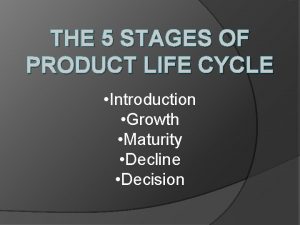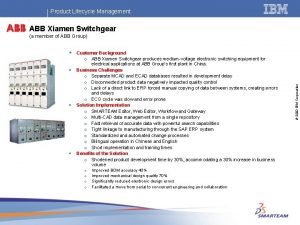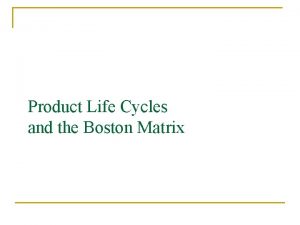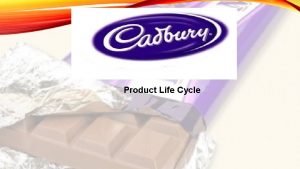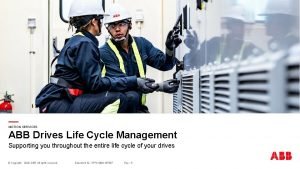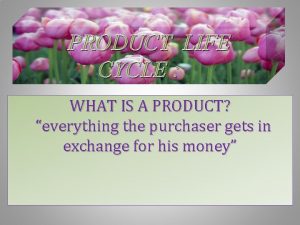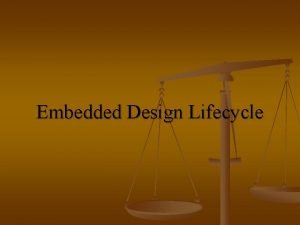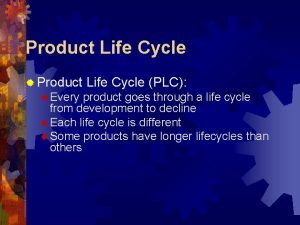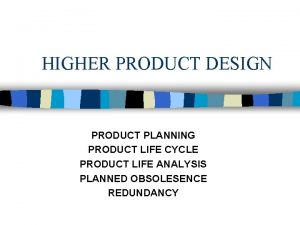Product Life Cycle SW Product Life Cycle HM











- Slides: 11

Product Life Cycle & SW Product Life Cycle HM 9/3/2007

Agenda Definition: Product Life Cycle Generic PLC Phases (4) SW PLC Phases (6) Time Line of PLC Summary of PLC Phases

Definition: Product Life Cycle The Product life cycle (PLC) describes a framework by which an organization manages the development of its products from inception to EOL

Generic PLC Phases (4) 1. 2. 3. 4. Exploration Planning Development Refresh (or Deployment 1 st time) PLC phases progress sequentially. Due to feedback from learning in some later phases, earlier phases experience corrections or completions; also, for relatively short periods, some phases overlap. The 4 phases of the generic PLC are:

SW PLC Phases (6) The more specific PLC for SW products refines the Exploration 1. into. Requirements Gathering a more elaborate requirements gathering and specification Similarly, Specification the Planning phase is broken into a High-level 2. effort. Requirements Detailed Design phase. The 6 phases of the 3. (architectural) Architecture and Design generic PLC are: 4. 5. 6. Detailed Design Implementation Validation and Verification

Time Line of PLC Opportunity Identification Scope Approval Opportunity Feasibility Approval Product Scope Approval (PSA) Opportunity Commit Approval Exploration Planning Product Post Mortem Product Qualified (PLQ) Production Candidate (PPC) Product Deployment Product Integration Exit Product Architecture Document (PAD) Refresh Development Product Integration Ready Opportunity To Product Map (OPM) Product Commit Approval (PCA) Product Design Complete Opportunity Assessment (OA) Product Feasibility Approval (PFA) Product Launch Qual Approval (PLA) (PQA)

Summary of PLC Phases Exploration Planning Development Refresh Exploration Phase analyzes market, business and technology trends & opportunities which identify product solutions, that are implementable and of evident added value. Planning Phase formalizes next level of detail including market requirements, decision times, product scope, usage, features, technology integration, and results in an approved, documented POR. Development Phase implements requirements defined in Planning Phase; its Milestones are synchronization points to quantify progress toward goal. Refresh Phase constitutes further product revisions (or EOL) after initial product launch; may include updates to software, hardware, and other technologies.

Requirements During Exploration phase of PLC, the customer’s requirements are gathered Requirements define what needs to be done, not how it can be implemented Takes ~ 20% of total time, calendar time Error-prone, when not communicating with real customer Requirements must be specified in written documents Documented requirements are signed off Experts need to contribute Not just pointy-haired managers Iterations of refinement Forming an agreement Change Control process defines, whether how requirements can be changed before EOL

Design During Planning phase of PLC, the product is designed Solution to requirements are designed in 2 phases Takes ~ 25% of total time, calendar time High-level (AKA architectural) design selects general, high-level methods Detailed design breaks architecture into small, implementable modules Including top-down approach Or bottom-up approach selection With inputs, outputs, globals, parameters Dependencies between modules Ideal to have few dependencies Detailed design results in actual plans, with milestones, measurable goals, bottle-necks, and recovery plans Result is an agreed Plan of Record (POR)

Implementation During Development phase of PLC, the detailed design documented in the POR is implemented I. e. the steps of the detailed design are actually executed Sequentially to use experience of programmer In parallel, to meet milestones on time Takes ~ 35% of total time, calendar time Can create large work force, progressing in parallel Milestones needs to be tracked, met, and if missed, a backup plan needs to be selected to meet final goal

V&V and Refresh During Refresh phase of PLC, the implemented product is tested Important to schedule some of V&V steps from day 1 Possible to test modules via Unit Testing Other parts tested via simulation Rest desk-tested, or inspected Takes ~ 25% of total time, calendar time If first release, run all Validation and Verification steps If subsequent release, focus on new features Total of all phases not = 100% Critical to have devised automated tools for testing
 Product life cycle kotler
Product life cycle kotler 5 stages of the product life cycle
5 stages of the product life cycle Scalloped pattern product life cycle
Scalloped pattern product life cycle Abb life cycle management
Abb life cycle management Boston matrix and product life cycle
Boston matrix and product life cycle Product life cycle presentation
Product life cycle presentation What is the maturity stage of the product life cycle
What is the maturity stage of the product life cycle Product life cycle of cadbury 2020
Product life cycle of cadbury 2020 Embedded development life cycle
Embedded development life cycle Abb life cycle management
Abb life cycle management Adulthhood
Adulthhood Embedded systems product design life cycle training
Embedded systems product design life cycle training

